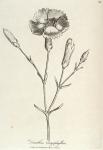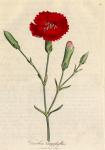
 ["Ut nomen traxisse ab odoris affinitate qualicunque dubium non est; ita nescio sane quae et unde sit barbara illa vox tunica." Bauh. Pin. p. c.]
["Ut nomen traxisse ab odoris affinitate qualicunque dubium non est; ita nescio sane quae et unde sit barbara illa vox tunica." Bauh. Pin. p. c.]
Synonyma. Caryophyllum rubrum. Pharm. Lond. & Edinb.
Caryophyllus hortensis simplex flore majore. Bauh. Pin. p. 208.
Caryophyllus simplex major. Gerard. Emac. p. 590. Vide Park. Parad. p. 306. Raii Hist. p. 986. Synop. p. 336.
Dianthus Caryophyllus. Hudson. Flor. Ang. Withering. Bot. Arr. p. 441.
α Caryophyllus hortensis simplex flore majore. C. Bauh. Clove Pink.
β Caryophyllus maximus ruber & variegatus. C. Bauh. Common Carnation. [Vide Aiton's Hort. Kew.]
Class Decandria. Ord. Digynia. Lin. Gen. Plant. 565.
Ess. Gen. Ch. Cal. cylindricus, 1-phyllus: basi squamis 4. Petals 5, unguiculata. Caps. cylindrica, 1-locularis.
Spec. Char. D. floribus solitariis, squamis calycinis subovatis brevissimis, corollis crenatis.
The root is perennial, firm, divided, and beset with many fibres: the stems are slender, smooth, branched, upright, jointed, of a glaucous, or sea green, colour, and rise from one to two feet in height: the leaves upon the stem are short, linear, and placed in pairs at the joints: those of the young shoots are numerous, narrow, pointed, smooth, entire, and of the same colour as the stalk: the flowers stand singly at the extremities of the branches, and are of a deep crimson colour: the calyx is tubular, cylindrical, divided at the mouth into five segments, and surrounded at the base with four oval pointed squamae: the corolla consists of five petals, which at the limb are roundish, patent, scolloped, fringed, and attached to the common receptacle by long narrow claws: the ten filaments are longer than the calyx, tapering, spreading towards the top, and furnished with compressed oblong antherae: the germen is oval: the styles two, slender, longer than the filaments, and their stigmata curled outwards: the capsule is cylindrical, and contains many small roundish seeds.
This fragrant plant is known to grow wild in several parts of England on old walls and in the crevices of rocks; [At Rochefter, Deal, Sandown, and other castles, plentifully. See Ray and Hudson.] but the flowers, which are pharmaceutically employed, are usually produced in gardens, where they become extremely luxuriant, and by the arts of culture those beautiful varieties raised which are so highly esteemed under the name of Carnations. The flowers of the Clove Pink, or as it is more commonly called, Clove July Flower, have a pleasant aromatic smell, somewhat allied to that of clove spice: their taste is bitterish and subastringent. "Rectified spirit, digested on the flowers, receives a much paler tincture than watery liquors, but extracts the whole of their active matter. In distillation or evaporation, spirit elevates much less than water; the spirituous extract retaining a considerable share of the fine smell of the flowers as well as their taste: its colour is purplish like that of the watery extract." [Lewis's Mat. Med. p. 205.]
Formerly these flowers were supposed to have considerable effect upon the nervous system, and were therefore recommended in headachs, faintings, palpitations of the heart, convulsions, tremors, &c. and S. Paulli says, that he found them of great use even in malignant fevers. [Quad. Bot. p. 242.] At present, however, they are valued merely for their sensible qualities, and the syrupus caryophylli rubri, which is the only officinal preparation of these flowers, is to be considered in this light: its pleasant flavour and fine colour rendering it an useful vehicle for other medicines.

